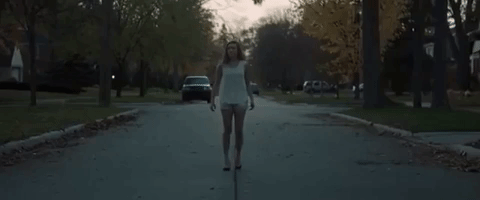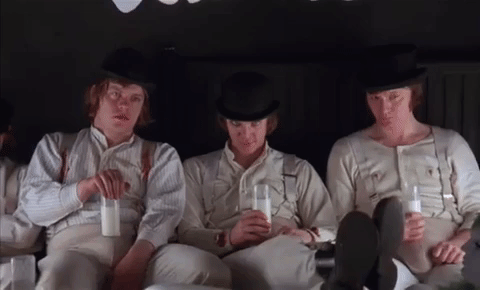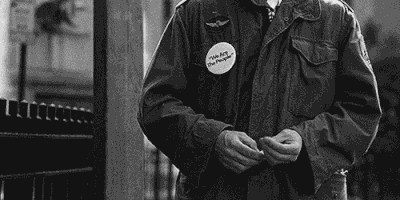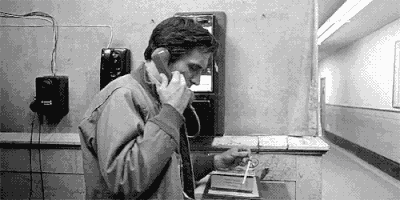Movement Terminology
Here are some basic terms that we’ll be using a lot when discussing camera movement (GIFs courtesy of Boords).
Static – A static camera doesn’t move; usually, this means that it is locked down on a tripod. Incidentally, “locked down” means just that: the pan and tilt of a camera are tightened and don’t change during the shot. Note that a static camera does not necessarily dictate a static scene, as actors and even the background can move while the camera remains still.
Pan – Panning is rotation along a horizontal axis. Usually, this is done on a tripod – panning changes the orientation of the camera, but not the position.

Tilt – Tilting is rotation along a vertical axis. Like a pan, this is usually done on a tripod and involves a change of orientation, not position.

Yaw/Cant – Yaw is rotation along the z-axis – essentially, adjusting the camera, so that the horizon is no longer level. This is sometimes referred to as cant (or a canted angle) or a Dutch angle. Yaw is not usually adjusted during a shot, although it can be done to create a disorienting effect.
Zoom – A zoom is a change in the focal length of the lens being used. While not technically a camera movement, zooming still creates the impression movement within the shot.

Dolly – A dolly shot moves the camera closer or farther away from the subject. This is usually done on some sort of cart or track. The word dolly is used to describe both the movement (“dolly in” or “dolly out”) and the specific piece of equipment used to create that movement.

Truck – A truck (or tracking) shot involves moving the camera from side to side. This creates an effect similar to a pan, but moves the camera instead of changing its orientation.

Pedestal/Boom – A pedestal shot involves moving the camera vertically. This can be done using a crane/jib or handheld. The effect is similar to a tilt, but moves the camera instead of changing its orientation.

Motivated and Unmotivated Movement
One term that you will probably hear frequently when discussing camera movement is motivation. This can be potentially confusing, so let’s discuss motivated and unmotivated camera movements.
Put simply, a motivated camera movement is a movement that follows something happening on the screen. If you pan to follow a character walking across the frame, that is a motivated camera movement. Unmotivated camera movements do not specifically follow something happening on screen. If you dolly away from a group of people at a party, that is an unmotivated camera movement.
It’s important to understand that motivated camera movements are not inherently better than unmotivated ones; an unmotivated camera movement can (and should) still be an intentional, planned camera movement that adds to the cinematic impact of the shot. Motivated camera movements are often nearly subliminal, since they mimic the way our eyes naturally follow action. Unmotivated camera movements tend to draw more attention to themselves; the audience notices them, so they often make a greater narrative and stylistic impact.
The following shot from the opening sequence of It Follows uses motivated camera movement. As the you women backs away, the camera dollies forward with her; when she begins to run, the camera pans, keeping her locked in the center of the frame. The audience is given the perspective of someone watching – and following – the actress, which is in keeping with the narrative of the film. The moving camera also keeps the character’s actions prominent in the frame, which gives them emphasis; we know that her backing away and running is important to the story.

This shot from A Clockwork Orange uses unmotivated camera movement. As the camera dollies slowly away from the actor, more and more of the surreal scene is revealed, but there is no specific action that the camera is following. Instead, the focus is on the bizarre environment and its menacing inhabitants. In other words, the emphasis is on the reveal, not the action.

However, motivated camera movements can also reveal narrative details. In the following shot from Taxi Driver, the movement of the actor’s hand clearly motivates the pedestal movement of the camera, but the end of the shot reveals the character’s surprising new hair style, which is narratively significant.

This is in contrast to an earlier scene in Taxi Driver, in which an unmotivated truck shot is used not as a reveal, but to emphasize the internal conflict happening within the character, who is abandoned by the camera as it moves from left to right.

Motivated and unmotivated camera movements can be used in the same sequence or even in the same shot. An effective director and cinematographer will use both to shape the style, tone, and narrative qualities of a film. We’ll be exploring why, when, and how to use camera movement intentionally in the weeks to come.
